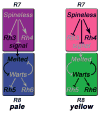The retinal mosaics of opsin expression in invertebrates and vertebrates
- PMID: 21557510
- PMCID: PMC3190030
- DOI: 10.1002/dneu.20905
The retinal mosaics of opsin expression in invertebrates and vertebrates
Abstract
Color vision is found in many invertebrate and vertebrate species. It is the ability to discriminate objects based on the wavelength of emitted light independent of intensity. As it requires the comparison of at least two photoreceptor types with different spectral sensitivities, this process is often mediated by a mosaic made of several photoreceptor types. In this review, we summarize the current knowledge about the formation of retinal mosaics and the regulation of photopigment (opsin) expression in the fly, mouse, and human retina. Despite distinct evolutionary origins, as well as major differences in morphology and phototransduction machineries, there are significant similarities in the stepwise cell-fate decisions that lead from progenitor cells to terminally differentiated photoreceptors that express a particular opsin. Common themes include (i) the use of binary transcriptional switches that distinguish classes of photoreceptors, (ii) the use of gradients of signaling molecules for regional specializations, (iii) stochastic choices that pattern the retina, and (iv) the use of permissive factors with multiple roles in different photoreceptor types.
Copyright © 2011 Wiley Periodicals, Inc.
Figures






Similar articles
-
Evolution of phototransduction, vertebrate photoreceptors and retina.Prog Retin Eye Res. 2013 Sep;36:52-119. doi: 10.1016/j.preteyeres.2013.06.001. Epub 2013 Jun 19. Prog Retin Eye Res. 2013. PMID: 23792002 Review.
-
Extraocular, rod-like photoreceptors in a flatworm express xenopsin photopigment.Elife. 2019 Oct 22;8:e45465. doi: 10.7554/eLife.45465. Elife. 2019. PMID: 31635694 Free PMC article.
-
Sexual Dimorphism and Retinal Mosaic Diversification following the Evolution of a Violet Receptor in Butterflies.Mol Biol Evol. 2017 Sep 1;34(9):2271-2284. doi: 10.1093/molbev/msx163. Mol Biol Evol. 2017. PMID: 28505307
-
The evolutionary history and spectral tuning of vertebrate visual opsins.Dev Biol. 2023 Jan;493:40-66. doi: 10.1016/j.ydbio.2022.10.014. Epub 2022 Nov 9. Dev Biol. 2023. PMID: 36370769 Free PMC article. Review.
-
Unique photoreceptor arrangements in a fish with polarized light discrimination.J Comp Neurol. 2011 Mar 1;519(4):714-37. doi: 10.1002/cne.22544. J Comp Neurol. 2011. PMID: 21246551
Cited by
-
Transcriptional control of cone photoreceptor diversity by a thyroid hormone receptor.Proc Natl Acad Sci U S A. 2022 Dec 6;119(49):e2209884119. doi: 10.1073/pnas.2209884119. Epub 2022 Dec 1. Proc Natl Acad Sci U S A. 2022. PMID: 36454759 Free PMC article.
-
Molecular logic behind the three-way stochastic choices that expand butterfly colour vision.Nature. 2016 Jul 14;535(7611):280-4. doi: 10.1038/nature18616. Epub 2016 Jul 6. Nature. 2016. PMID: 27383790 Free PMC article.
-
Patterning the insect eye: From stochastic to deterministic mechanisms.PLoS Comput Biol. 2018 Nov 15;14(11):e1006363. doi: 10.1371/journal.pcbi.1006363. eCollection 2018 Nov. PLoS Comput Biol. 2018. PMID: 30439954 Free PMC article.
-
Dissection and immunohistochemistry of larval, pupal and adult Drosophila retinas.J Vis Exp. 2012 Nov 14;(69):4347. doi: 10.3791/4347. J Vis Exp. 2012. PMID: 23183823 Free PMC article.
-
Heterochromatin-mediated gene silencing facilitates the diversification of olfactory neurons.Cell Rep. 2014 Nov 6;9(3):884-92. doi: 10.1016/j.celrep.2014.10.001. Epub 2014 Oct 30. Cell Rep. 2014. PMID: 25437545 Free PMC article.
References
-
- Ahnelt PK, Kolb H. The mammalian photoreceptor mosaic-adaptive design. Prog Retin Eye Res. 2000;19:711–777. - PubMed
-
- Akhmedov NB, Piriev NI, Chang B, Rapoport AL, Hawes NL, Nishina PM, Nusinowitz S, Heckenlively JR, Roderick TH, Kozak CA, Danciger M, Davisson MT, Farber DB. A deletion in a photoreceptor-specific nuclear receptor mRNA causes retinal degeneration in the rd7 mouse. Proc Natl Acad Sci U S A. 2000;97:5551–5556. - PMC - PubMed
-
- Applebury ML, Antoch MP, Baxter LC, Chun LL, Falk JD, Farhangfar F, Kage K, Krzystolik MG, Lyass LA, Robbins JT. The murine cone photoreceptor: a single cone type expresses both S and M opsins with retinal spatial patterning. Neuron. 2000;27:513–523. - PubMed
-
- Applebury ML, Farhangfar F, Glosmann M, Hashimoto K, Kage K, Robbins JT, Shibusawa N, Wondisford FE, Zhang H. Transient expression of thyroid hormone nuclear receptor TRbeta2 sets S opsin patterning during cone photoreceptor genesis. Dev Dyn. 2007;236:1203–1212. - PubMed
Publication types
MeSH terms
Substances
Grants and funding
LinkOut - more resources
Full Text Sources
Research Materials

